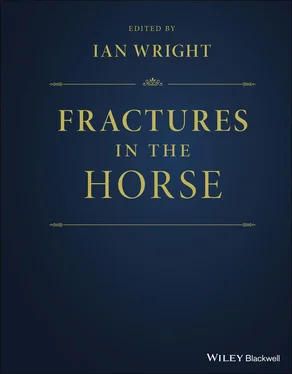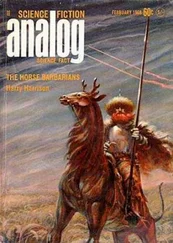1 Cover
2 Title Page
3 Copyright Page
4 Dedication Page
5 Preface
6 List of Contributors
7 1 Introduction Historical Review The Future References
8 2 Bone Structure and Function Introduction Bone Architecture Function Adaptation Stress Protection Conclusions References
9 3 Pathophysiology of Fractures Material Features of Bone Failure Loading Modes Relationships Between Location and Morphology The Mechanical Behaviour of Bone Monotonic and Repetitive Stress Fractures Classifications of Fractures References
10 4 Fracture Epidemiology State of Knowledge Geographic, Discipline and Horse Level Incidence Risk Factors, Predisposing Factors and Evidence Predictability and Potential for Effective Screening References
11 5 Imaging Fractures Introduction Radiography Ultrasonography Nuclear Scintigraphy Computed Tomography Magnetic Resonance Imaging Positron Emission Tomography References
12 6 Bone Healing Introduction and Principles Phases of Bone Healing Cellular and Humeral Influences on Bone Healing Mechanical Influences on Bone Healing Monitoring Bone Healing Healing of Stress Fractures Healing of Incomplete Fractures Healing of Complete Non‐displaced Fractures Healing of Displaced Fractures Healing of Reduced and Repaired Fractures Healing of Repaired But Non‐reduced and/or Unstable Fractures Effects of Internal Fixation on Bone Healing Effects of External Fixation on Bone Healing Intrinsic Factors That Affect Healing Exogenous Factors That Influence Fracture Healing Exogenous Devices Conclusions References
13 7 Triage and Emergency Care Introduction Racecourse Fractures Insurance Clinical Assessment Clinical Features of Specific Fractures Sedation Analgesia Radiography Ultrasonography Wounds Principles of Temporary Immobilization Techniques for Temporary Immobilization Recommended Emergency Support Transport Ambulances Nursing and Supportive Care References
14 8 Surgical Equipment, Implants and Techniques for Fracture Repair Principles Equipment for Internal Fixation Screw Types, Sizes and Techniques Plates Intramedullary Implants Wire and Cable Reduction Devices Aiming Devices References
15 9 Pre‐operative Planning and Preparation Introduction Detailed Plan of the Surgical Procedure Instruments, Implants and Disposable Items Personnel Imaging Modalities Preparation of the Operating Room Preparation of the Patient Peri‐operative Antimicrobials Pain Management Strategies for Complications Sign Out Recovery Open Fractures References
16 10 Anaesthesia and Analgesia Abbreviations Pre‐operative Evaluation and Consideration Pre‐operative Analgesia Induction of Anaesthesia Maintenance of Anaesthesia and Intra‐operative Analgesia Peripheral Nerve Blocks Monitoring and Cardiovascular Support Recovery from Anaesthesia Anaesthesia of Foals References
17 11 Intra‐operative Complications Technical Errors Fracture Reduction Splitting Bone Fragments Implant Location Growth Plates Screw Length Locking Implants Screw Breakage and Damage Instrument Breakage Inability to Tighten or Stripping of Screws Asepsis and Prevention of Surgical Site Infection Communication References
18 12 Standing Fracture Repair Development and Philosophy Indications and Contra‐indications Case Selection Facilities and Equipment Pre‐operative Preparation, Sedation and Local Anaesthesia Operative Technique Post‐operative Care Rest, Review and Return to Training Summary References
19 13 External Coaptation Introduction Casts Transfixation Casts External Skeletal Fixation Devices References
20 14 Post‐operative Complications Construct Instability Infection Supporting Limb Laminitis Limb Deformities Post‐operative Colic References
21 15 Convalescence and Rehabilitation Introduction Rehabilitation Goals Pain Modulation Physiotherapeutic Modalities Physiotherapeutic Exercise Outcome Measures Summary References
22 16 Fractures of the Distal Phalanx Anatomy Fracture Types Incidence and Causation Clinical Features and Presentation Imaging and Diagnosis Acute Fracture Management Treatment Options and Recommendations Specific Management Techniques Results References
23 17 Fractures of the Navicular Bone Anatomy Fracture Incidence and Aetiology Parasagittal Fractures Fragment Removal Palmar/Plantar Digital Neurectomy References
24 18 Fractures of the Middle Phalanx Anatomy Fracture Types Osteochondral Chip Fractures of the Proximal Articular Surface Axial Fractures Fractures of the Palmar/Plantar Eminences Proximal Interphalangeal Arthrodesis Comminuted Fractures Fractures of the Distal Articular Surface References
25 19 Fractures of the Proximal Phalanx Anatomy Fracture Types Incidence and Causation Clinical Features and Presentation Imaging and Diagnosis Acute Fracture Management Treatment Options and Recommendations Results References
26 20 Fractures of the Proximal Sesamoid Bones Anatomy Aetiology Incidence Classification Apical Fractures Abaxial Fractures Uniaxial Mid‐body Fractures Basilar Fractures Sagittal/Axial Fractures Fractures Caused by External Trauma Destabilizing Fractures of the Proximal Sesamoid Bones References
27 21 Fractures of the Distal Condyles of the Third Metacarpal and Third Metatarsal Bones Anatomy Fracture Types Incidence and Causation Clinical Features and Presentation Imaging and Diagnosis Acute Fracture Management Treatment Options and Recommendations Techniques for Treatment Complex and Complicated Fractures Results References
28 22 Diaphyseal Fractures of the Third Metacarpal and Third Metatarsal Bones Anatomy and Biomechanical Considerations Fracture Types Incidence and Aetiology Dorsal Cortical Stress Fractures Incomplete Longitudinal Fractures Avulsion Fractures Associated with the Origin of the Suspensory Ligament Transverse Stress Fracture of the Distal Diaphysis Complete Diaphyseal Fractures References
29 23 Fractures of the Second and Fourth Metacarpal and Metatarsal Bones Anatomy Fracture Types Incidence and Causation Clinical Features and Presentation Imaging and Diagnosis Treatment References
30 24 Fractures of the Carpus Anatomy Osteochondral Chip Fractures (Fragments) of the Dorsal Articular Margins Arthroscopic Surgery for the Repair of Carpal Chip Fractures Avulsion Fragments Associated with the Palmar Intercarpal Ligaments Osteochondral Fragments in the Palmar Compartments of the Carpal Joints Carpal Slab Fractures Accessory Carpal Bone Fractures References
31 25 Fractures of the Radius Anatomy Fracture Types and Causation Clinical Features and Presentation Imaging and Diagnostics Acute Fracture Management Treatment Options and Recommendations Physeal Fractures Post‐operative Management Results References
32 26 Fractures of the Ulna Anatomy Incidence Aetiology Fracture Types and Classification Clinical Signs Radiography and Radiology Emergency Care Treatment Options and Recommendations Conservative Treatment Fracture Repair Fragment Removal Recovery from Anaesthesia Post‐operative Care and Convalescence Results References
33 27 Fractures of the Humerus Anatomy Fractures of the Greater Tubercle Fractures of the Deltoid Tuberosity Stress Fractures Physeal Fractures Diaphyseal Fractures References
34 28 Fractures of the Scapula Anatomy Fracture Types Incidence and Causation Clinical Features and Presentation Imaging and Diagnosis Treatment References
35 29 Fractures of the Tarsus Anatomy Fractures of the Tarsal Bones Fractures of the Medial Malleolus of the Tibia Fractures of the Lateral Malleolus of the Tibia Fractures of the Distal Intermediate Ridge of the Tibia Sagittal Fractures of the Talus Fractures of the Trochlear Ridges of the Talus Fractures of the Medial Tubercles of the Talus Other Fractures of the Talus Fractures of the Calcaneus Fractures of the Central Tarsal Bone Fractures of the Third Tarsal Bone Fractures of the Proximal Third Metatarsal Bone Other Tarsal Fractures References
Читать дальше












